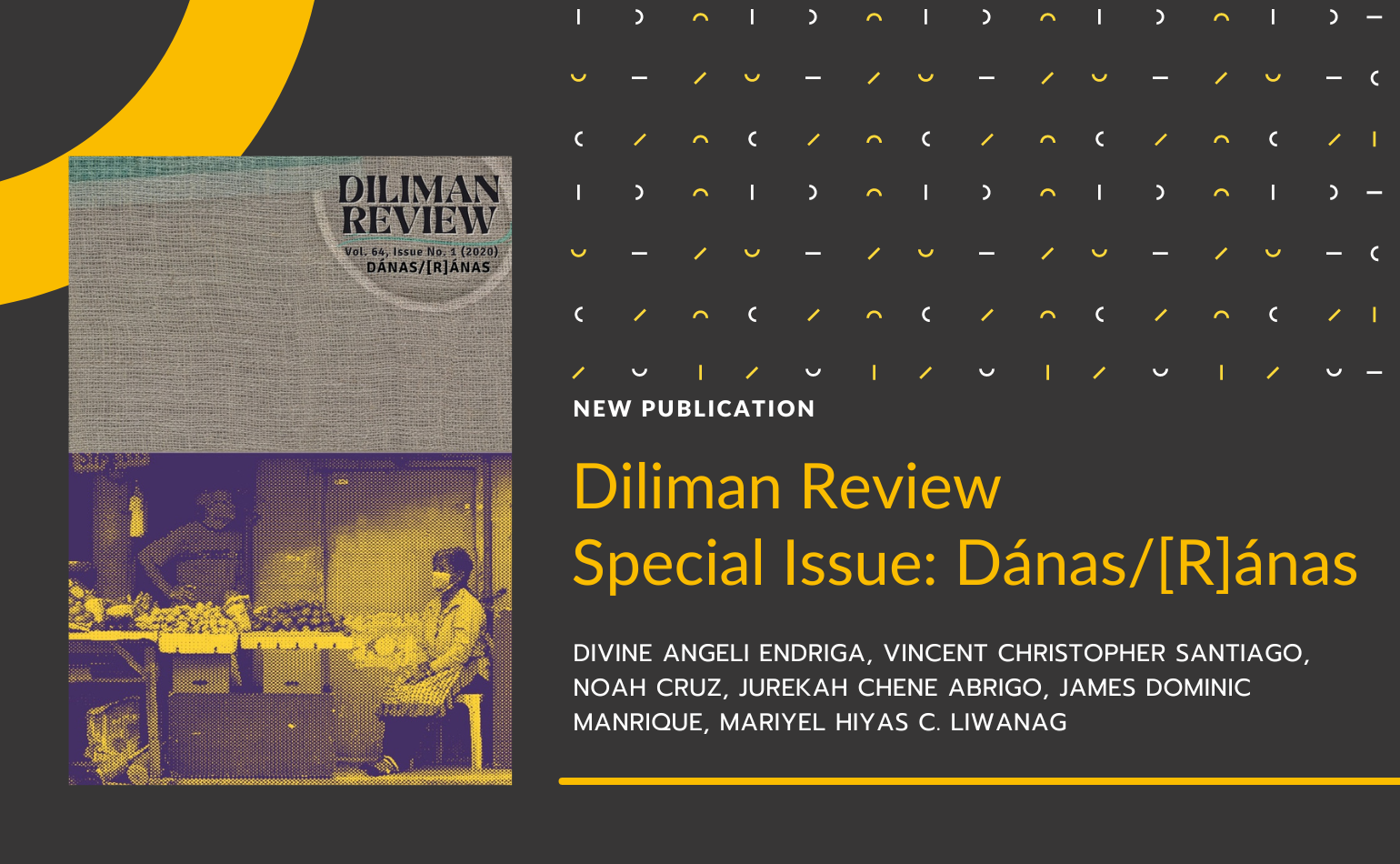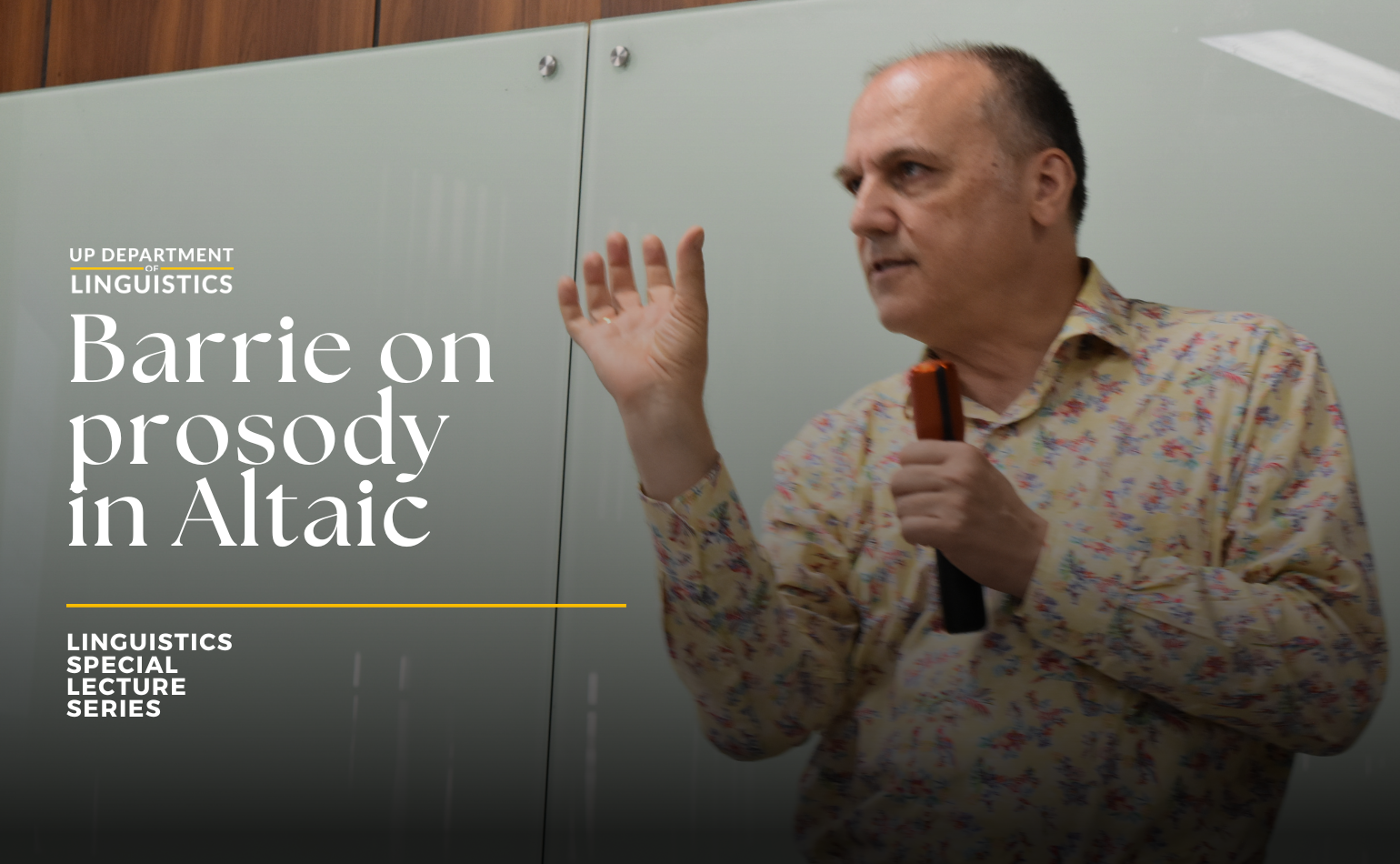
The Diliman Review: Dánas/[R]ánas – COVID-19 Special Issue, edited by Dr. Aldrin Lee, is finally out. Among the articles included in the issue are papers authored by some of our faculty, staff, students, and alumni.
The article “Language of the Pandemic: The #LexiCOVID Project,” authored by Divine Angeli Endriga, Vincent Christopher Santiago, Noah Cruz, Jurekah Chene Abrigo, and James Dominic Manrique, is the product of their yearlong project of documenting the words that sprouted during the height of the COVID-19 pandemic, as well as the concepts that Filipinos came to associate with the pandemic. Below is the abstract of their paper.
Language of the Pandemic: The #LexiCOVID Project
The unprecedented nature of the COVID-19 pandemic has wrought a lot of changes in our lives and in our use of language. Scientific and technical terms have become part of our daily conversations. Words like coronavirus, self-quarantine, incubation period, while common to those in the medical field, were used perhaps infrequently by the general population, until recently. Tony Thorne called it the “medicalisation” of everyday language. (King’s College London, 2020). The #LexiCOVID Project was an online initiative carried out during the month of August 2020. The main goal was to look into words and concepts that Filipinos associated with the pandemic. The results of the project were then disseminated through a series of online posters on the UP Department of Linguistics Facebook page (shorturl.at/itIMR) and Instagram account (shorturl.at/yDL18). Responses to our survey featured words already in use, whether in a local or foreign language, but only recently gained usage outside their technical fields e.g., flatten(ing) the curve. Some have undergone shifts in meaning due to how they were being used in mass and social media e.g., social distancing. Some describe our new work arrangements and modes of interaction: WFH (work from home), and contactless delivery. Some neologisms in the year 2020 were also documented, e.g., Zoomustahan. All in all, what emerged from our results is a record of our lives in lockdown describing our collective experience and sense-making.
Noah Cruz also has a sole-authored article in the issue entitled “Metapora sa Panahon ng Pandemya: Ilang Tala Tungkol sa mga Metaporang may Kaugnayan sa COVID-19 Pandemic sa Wikang Filipino” (Metaphors in the Time of a Pandemic: Some Notes on the Filipino Language Metaphors related to the COVID-19 Pandemic). Below is the abstract to his research paper.
Metapora sa Panahon ng Pandemya: Ilang Tala Tungkol sa mga Metaporang may Kaugnayan sa COVID-19 Pandemic sa Wikang Filipino
Hindi maitatangging napakalaki ng naging epekto ng pandemya sa pamumuhay ng mga tao sa iba’t ibang sulok ng daigdig. Hinubog ng ating mga karanasan sa panahon ng krisis na ito ang iba’t ibang aspekto ng ating mga buhay, maging ang paraan kung paano natin tinitingnan ang mismong pandemya. Sa ganitong diwa, nilalayon ng pananaliksik na ito na mailahad ang iba’t ibang pagtingin ng mga Pilipino sa pandemya sa pamamagitan ng pagsusuri sa mga metaporang ginagamit sa wikang Filipino upang ilarawan ang COVID-19 pandemic. Upang maabot ang layunin ng papel, dalawang corpora ang ginamit. Mula sa corporang ito ay itinala ang mga metaporikal na ekspresyong naglalarawan sa pandemya. Batay sa mga nakalap na datos sa corpora, apat na pangunahing tema ang natukoy: ANG PANDEMYA AY DIGMAAN, ANG PANDEMYA AY UNOS, ANG PANDEMYA AY SÚNOG, at ANG COVID-19 AY NILALANG NA MAYROONG PAG-IISIP. Natuklasan sa pag-aanalisa sa mga metaporang ito na ang mga metaporang ginagamit kaugnay ng pandemya ay hindi lamang mga payak na ekspresyong lumilitaw sa mga usapan bagkus ay mayroon itong malawak na implikasyon sa kamalayan ng mga mamamayan at sa pagkilos ng mga nakapangyayaring sektor ng lipunan.
MA Ling alum Mariyel Hiyas Liwanag (Batch 2015) also published a paper entitled “Ang Pihit tungong Emergency Remote Learning ng English Bridge Program sa Gitna ng Pandemya” (The Pivot towards Emergency Remote Learning of the English Bridge Program in the Midst of the Pandemic).
Ang Pihit tungong Emergency Remote Learning ng English Bridge Program sa Gitna ng Pandemya
Tinalakay sa papel na ito ang karanasan ng pagpapatupad ng isang programang ekstensyon gamit ang narrative inquiry at emergency remote learning. Layunin ng papel na ito na ibahagi ang karanasan sa paghahanda ng isang buong asingkronus na emergency remote learning para sa isang Bridge Program para sa asignaturang Ingles. Isinalaysay sa papel na ito ang paghahanda at pagpapatupad ng emergency remote learning para sa mga papasok pa lamang na mag-aaral sa Unibersidad ng Pilipinas Los Baños, magmula sa pagpili ng learning management system, pagsulat ng mga modyul, paglikha ng mga pagtatasa ng angkop sa klase, at pagpili ng mga midyum pangkomunikasyon. Bagaman mayroong mga puwang sa pagpapaunlad ng ipinatupad na programa sa emergency remote learning, mayroong mga praktika na maaaring gamitin at ihanda para sa ganitong pihit sa pagtuturo. Sa maikling panahon na ibinigay sa paghahanda ng programa, tiniyak na makalalahok ang lahat ng mga mag-aaral. Siniguro na aksesible sa mga mag-aaral ang mga materyal, gawain at komunikasyon. Dagdag, pinaigting rin ang pagtatasa at komunikasyon upang mawala ang pangamba lalo na at kalakhan sa kanila ay mula sa pisikal na silid-aralan kung saan nagkikita-kita ang guro at ang mga mag-aaral bago pumasok sa unibersidad.
In the introduction to this special issue, Dr. Lee writes that he chose the title of the volume as an ode to his core academic field because it “highlights the complementariness of theories and experiences in academic discourses on COVID-19. This pair of words in Tagalog exhibits a linguistic phenomenon we call allophony, wherein two non-contrastive sounds appear in complementary distribution. It represents a case wherein one phonological segment may be articulated differently, given a specific conditioning environment. It underlines the significance of context in diversifying the human experience of the COVID-19 pandemic.”
Congratulations to Dr. Lee, as well as to Michael Manahan, who designed the issue cover, and to all our colleagues whose papers were published in the special issue!
Published by UP Department of Linguistics



